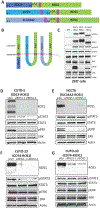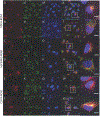Differential Subcellular Localization Regulates Oncogenic Signaling by ROS1 Kinase Fusion Proteins
- PMID: 30538120
- PMCID: PMC6359944
- DOI: 10.1158/0008-5472.CAN-18-1492
Differential Subcellular Localization Regulates Oncogenic Signaling by ROS1 Kinase Fusion Proteins
Abstract
Chromosomal rearrangements involving receptor tyrosine kinases (RTK) are a clinically relevant oncogenic mechanism in human cancers. These chimeric oncoproteins often contain the C-terminal kinase domain of the RTK joined in cis to various N-terminal, nonkinase fusion partners. The functional role of the N-terminal fusion partner in RTK fusion oncoproteins is poorly understood. Here, we show that distinct N-terminal fusion partners drive differential subcellular localization, which imparts distinct cell signaling and oncogenic properties of different, clinically relevant ROS1 RTK fusion oncoproteins. SDC4-ROS1 and SLC34A2-ROS1 fusion oncoproteins resided on endosomes and activated the MAPK pathway. CD74-ROS1 variants that localized instead to the endoplasmic reticulum (ER) showed compromised activation of MAPK. Forced relocalization of CD74-ROS1 from the ER to endosomes restored MAPK signaling. ROS1 fusion oncoproteins that better activate MAPK formed more aggressive tumors. Thus, differential subcellular localization controlled by the N-terminal fusion partner regulates the oncogenic mechanisms and output of certain RTK fusion oncoproteins. SIGNIFICANCE: ROS1 fusion oncoproteins exhibit differential activation of MAPK signaling according to subcellular localization, with ROS1 fusions localized to endosomes, the strongest activators of MAPK signaling.
©2018 American Association for Cancer Research.
Conflict of interest statement
Figures





References
-
- Lynch TJ, Bell DW, Sordella R, Gurubhagavatula S, Okimoto RA, Brannigan BW, et al. Activating mutations in the epidermal growth factor receptor underlying responsiveness of non-small-cell lung cancer to gefitinib. N Engl J Med. Massachusetts Medical Society; 2004;350:2129–39. - PubMed
-
- Pao W, Hutchinson KE. Chipping away at the lung cancer genome. Nat Med. Nature Publishing Group; 2012;18:349–51. - PubMed
-
- Li C, Sun Y, Fang R, Han X, Luo X, Wang R, et al. Lung adenocarcinomas with HER2-activating mutations are associated with distinct clinical features and HER2/EGFR copy number gains. J Thorac Oncol. 2012;7:85–9. - PubMed
-
- Stephens P, Hunter C, Bignell G, Edkins S, Davies H, Teague J, et al. Lung cancer: intragenic ERBB2 kinase mutations in tumours. Nature. Nature Publishing Group; 2004;431:525–6. - PubMed
-
- Takeuchi K, Choi YL, Togashi Y, Soda M, Hatano S, Inamura K, et al. KIF5B-ALK, a novel fusion oncokinase identified by an immunohistochemistry-based diagnostic system for ALK-positive lung cancer. Clin Cancer Res. 2009;15:3143–9. - PubMed
Publication types
MeSH terms
Substances
Grants and funding
LinkOut - more resources
Full Text Sources
Other Literature Sources
Medical
Research Materials

